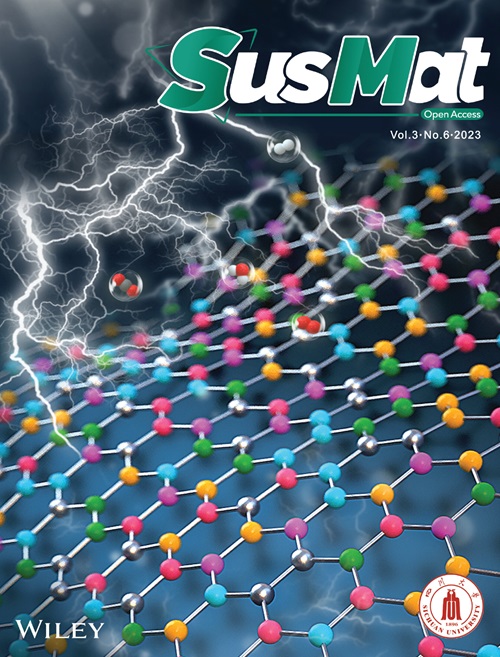Modulating CsPbl3 crystallization by using diammonium agent for efficient solar cells
IF 18.7
1区 材料科学
Q1 CHEMISTRY, MULTIDISCIPLINARY
引用次数: 0
Abstract
Cesium lead triiodide (CsPbI3) perovskite receives tremendous attention for photovoltaic applications, owing to its remarkable thermal stability and optoelectronic properties. However, realizing the CsPbI3 perovskite with high black‐phase stability and optoelectronic properties remains a significant challenge, which largely affects the photovoltaic performance of perovskite solar cells (PSCs). Herein, aromatic ammonium agents are used to modulate the crystallization of the CsPbI3 perovskite to improve its black‐phase stability and optoelectronic properties for efficient PSCs. Systemically experimental studies and comprehensively theoretical calculations are performed, which reveal that histammonium dihydrochloride (HACl2) could strongly couple with the perovskite during its crystallization, leading to faster nucleation and slower perovskite growth, and thus modulating the crystallization dynamics of the perovskites. Moreover, the residual diammonium cations (HA2+) distributed at the grain boundaries and on the surface of the perovskites can effectively passivate defects through electrostatic interactions, substantially suppressing trap‐assisted nonradiative recombination, and prompting more matched perovskite surface energetics. Consequently, the photovoltaic performance of CsPbI3 PSCs is largely improved because of a combination of enhanced crystallinity and optoelectronic properties of the perovskites. This work offers a new avenue to prepare inorganic perovskites with high optoelectronic properties for photovoltaics.使用二铵剂调节 CsPbl3 结晶,实现高效太阳能电池
由于具有显著的热稳定性和光电特性,三碘化铯铅(CsPbI3)包晶石在光伏应用领域受到极大关注。然而,实现具有高黑相稳定性和光电特性的 CsPbI3 包晶石仍然是一项重大挑战,这在很大程度上影响了包晶石太阳能电池(PSCs)的光电性能。本文利用芳香族铵剂来调节 CsPbI3 包晶体的结晶,从而提高其黑相稳定性和光电性能,以实现高效的 PSCs。通过系统的实验研究和全面的理论计算,我们发现组铵二盐酸盐(HACl2)能在包晶石的结晶过程中与包晶石发生强烈耦合,从而导致包晶石成核速度加快、生长速度减慢,进而调节包晶石的结晶动力学。此外,分布在晶界和包晶表面的残留二铵阳离子(HA2+)可以通过静电相互作用有效地钝化缺陷,从而大大抑制陷阱辅助的非辐射重组,促使包晶表面能量更加匹配。因此,CsPbI3 PSCs 的光电性能在很大程度上得到了改善,这是因为包晶体的结晶度和光电特性得到了增强。这项研究为制备具有高光电特性的无机光伏包晶提供了一条新途径。
本文章由计算机程序翻译,如有差异,请以英文原文为准。
求助全文
约1分钟内获得全文
求助全文
来源期刊
自引率
4.20%
发文量
0
期刊介绍:
SusMat aims to publish interdisciplinary and balanced research on sustainable development in various areas including materials science, engineering, chemistry, physics, and ecology. The journal focuses on sustainable materials and their impact on energy and the environment. The topics covered include environment-friendly materials, green catalysis, clean energy, and waste treatment and management. The readership includes materials scientists, engineers, chemists, physicists, energy and environment researchers, and policy makers. The journal is indexed in CAS, Current Contents, DOAJ, Science Citation Index Expanded, and Web of Science. The journal highly values innovative multidisciplinary research with wide impact.

 求助内容:
求助内容: 应助结果提醒方式:
应助结果提醒方式:


